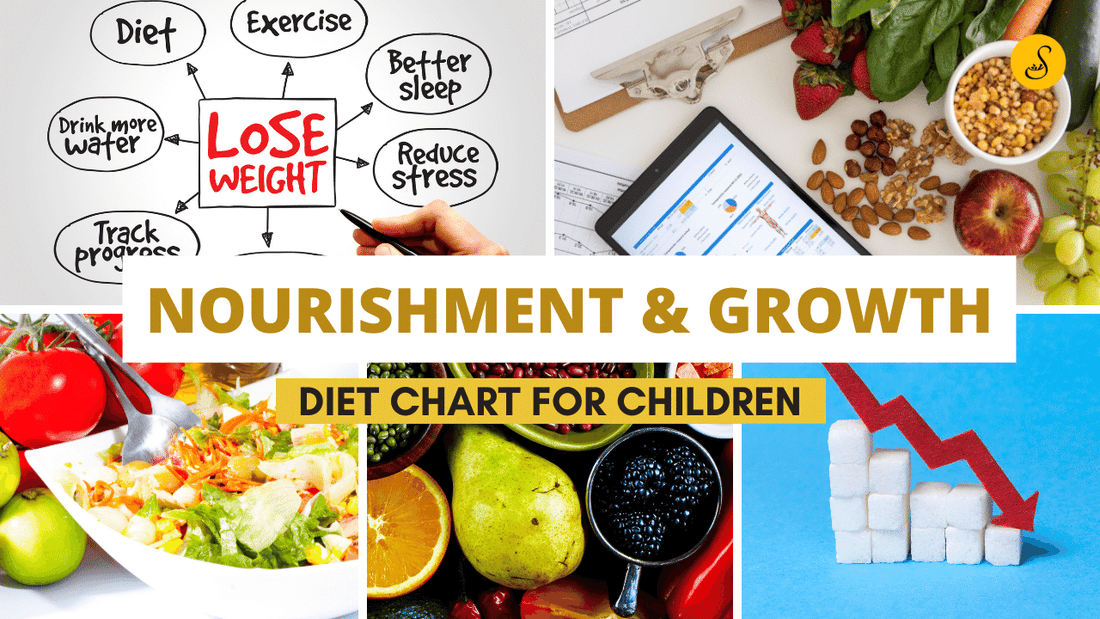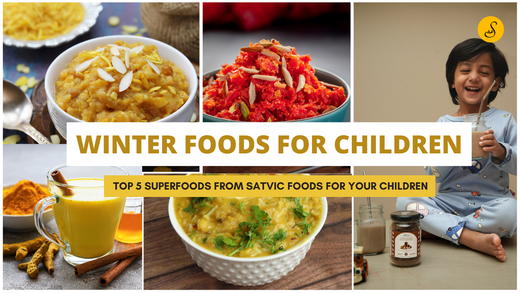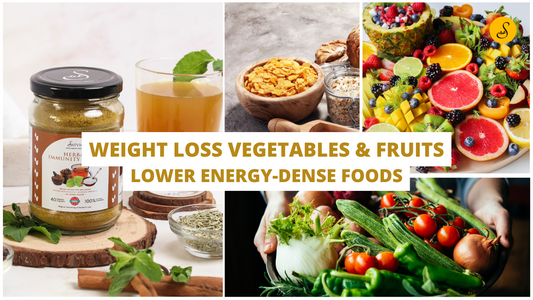Diet Chart for Children in 2023: Nourishment and Growth

Diet chart for children varies with age as children are always active and engaged in various extracurricular activities that require physical and mental energy. As they grow, their body’s nutritional needs also change. Children aged 5 to 12 years experience rapid development, increasing their nutritional requirements to meet their body's demands.
Cultivating healthy eating habits for children in early life can be a challenge for parents. However, with the proper nutritional guidance for kids, parents can ensure the right nutrients and energy needed to thrive and reach their full cognitive potential. In this blog, Satvic Foods will guide you through creating a healthy diet chart for your children of age 5 to 12 years. Dive in to explore the world of healthy eating for your picky little ones.
What is a Nutrition Plan for Children?
There are specific nutritional considerations that parents need to know. Follow the list to understand the basics of child nutrition:
Protein: Protein breakdown into amino acids, which build muscle and repair tissues. Foods such as lentils, peas, beans, and dairy products are protein-rich.
Carbohydrates: Carbohydrates are the body's primary energy source. Foods like fruits, vegetables, legumes, and whole grains like quinoa are the best dietary option.
Vitamins and Minerals: Vitamins and minerals like vitamin B6, vitamin C, zinc, iron, and magnesium are essential for a wide range of bodily functions, like healthy eyes, skin health, focus, and attention, among others. You can include a variety of whole foods, leafy green vegetables, and crucifers like broccoli. Vitamin C is abundant in citrus fruits and leafy greens, while calcium is abundant in dairy products.
Healthy Fats: Fats are essential for the protective layering of organs. Healthy fats further maintain blood lipid and cholesterol levels. Allow children to consume healthy fat from nuts, seeds, and avocados.
With the growing age and activities children are involved in, their nutritional requirements also increase and vary. Hence, increase the portion sizes accordingly. You may refer to the below diet chart to understand the daily dietary and nutritional needs of children aged 5 to 12 years.
|
Sunday |
Monday |
Tuesday |
Wednesday |
Thursday |
Friday |
Saturday |
|
|
Breakfast |
A whole grain bread sandwich with tomatoes, cucumbers, and capsicum + A cup of milk |
Poha + Banana milk |
Idli Sambhar + A cup of milk |
Stuffed paratha + A cup of milk |
Upma + Mixed fruit milkshake |
Moong chilla + A cup of milk |
Vegetable idli + A cup of milk |
|
Brunch |
A cup of seasonal fruits |
A handful of mixed dried fruits, nuts, and seeds |
Fruits smoothie topped with chia seeds and almonds |
Yogurt with fruits |
Tomato soup |
Mixed fruit salad |
Fruits with nuts |
|
Lunch |
Two chapati + Pumpkin curry |
Pulses/ sprouts curry + chapati/ rice |
Veg pulao + Curd raita |
Dal-rice + Mix veg curry with paneer. |
Chana dal/ Chickpeas curry + paratha |
Paneer pulao + Curd with salad |
Moong dal khichdi + Tossed vegetables |
|
Evening Snacks |
Ragi paratha |
Upma with carrots, cabbage, and capscium |
Mixed fruit custard topped with nuts |
Oats cracker + Strawberry Milkshake |
Boiled sprouts/ legumes |
Whole wheat bread sandwich with green chutney |
Vegetable pancake |
|
Dinner |
Sambhar and rice |
Chapati and Chana curry |
Mixed veg khichdi |
Veg pulao with salads |
Paneer paratha |
Daliya khichdi |
Aloo paratha with green chutney |
|
Bed-time |
A cup of whole milk |
A cup of whole milk |
A cup of whole milk |
A cup of whole milk |
A cup of whole milk |
A cup of whole milk |
A cup of whole milk |
What are the 5 Healthy Eating Habits to Give Your Kids?
Only providing a healthy and balanced diet for children is not enough. Parents must also indulge kids in developing healthy eating habits to understand the importance of nutrition and the role of homemade brain-boosting foods. It will help them develop healthy eating habits early for a lifetime of good health.
Add Colors: Colors make the plate more appetizing. Let your little ones choose their fruit and vegetables of different colors. Including your picky eaters in meal planning will help them develop a taste for various healthy foods, understand nutrition, and feel responsible for the food on their plates.
Importance of Breakfast: Apart from eating, children must also understand the importance of each meal. Parents can start this right from the morning breakfast because when kids grow up as teenagers or move out to live independently, the breakfast habit quickly slips away.
Children learn what they see. As a parent, you may showcase to kids by having a fruit or a glass of milk to kick-start the day, even when you are busy in your daily routines. By prioritizing your health, you can inspire your child to care for their health.
Fix One Place to Eat: It is essential to teach children eating discipline and table manners to avoid the risk of choking while also being confident in social situations.
Eat Slowly: Chewing food is essential to send signals from stomachs to their brains to register satiety and prevent overeating.
Water: Children tend to get demanding for sugary drinks. Practice having a glass of water when they insist on sugary beverages. Explain the importance of hydration, or you may also get them fancy-colored bottles to carry around. It will help them develop a habit of drinking water instead of processed drinks.
What is the Healthy Diet Chart for Kids?
A healthy diet chart for kids emphasizes a balanced diet, combining healthy fats, carbs, protein, vitamins, and minerals to ensure optimal body functioning. You may consider some of the below options and make it more versatile as per your pick eaters' demands:
Breakfast: Give overnight soaked dry fruits and seeds such as almonds, pumpkin seeds, and raisins before breakfast. Add easy-on-stomach foods like dosa and idli with sambhar or oatmeal with nuts, berries, and nut butter.
You may also add Satvic Foods’ Almond Peanut Butter (Crunchy), made with high-quality nuts and seeds, for a delicious and healthy addition to your breakfast routine with 30g of protein per 100g. You can offer it as a spread on wholegrain toast or on sliced fruits.

Check out Satvic Foods’ Almond Peanut Butter (Crunchy) for a finger-licking experience!
Brunch: Including fruit salad made of seasonal fruits is the most reasonable option. Having seasonal fruits will nourish with the required minerals and vitamins, along with the habit of having healthy snacks.
Lunch: Lunch offers an opportunity to pack in complete nutrition. You may include moong or tur dal with rice, mix-vegetable khichadi, and tossed vegetables or curries. Or you can provide chapatis with vegetables or stuffed paratha with sliced tomatoes and lettuce salads.
Mid-Afternoon or Early Evening Snack: Children need something to eat throughout the day. Therefore, choose snacks that are nutrient-dense and not just empty calories. You can make protein-rich foods such as moong dal chilla added with veggies such as capsicum and tomatoes with cucumber or pineapple raita. Or give them Greek yogurt with honey, nuts, and berries.
Dinner: You can get as creative with flavors and textures with various food groups. You may include roasted sweet potatoes, broccoli, and vegetable pulao, or add dal and pulses with mixed vegetables like spinach, beetroot, and carrots. Incorporate salad from early childhood to make it a healthy habit.
Bed-time: A glass of milk before bed is crucial to your child’s physical and cognitive development. Suppose your picky eater doesn’t like the taste of plain milk. In that case, you may try adding natural taste enhancers like organic jaggery, honey, and cardamom or Satvic Foods' Chocolate Milk Masala. Its nuts, seeds, and cocoa powder are carefully selected and blended in proportion to offer a delectable taste that your kids will love.

Choose Satvic Foods' Chocolate Milk Masala for your child's healthy development!
How do I Get My Picky Eater to Eat More Vegetables?
Get involved with your children by sharing meals and leading as an example. Don’t react fast to their tantrums. Children may prefer one type of vegetable over another, so it's essential to experiment with different vegetable options to find what works best for your child. You may also sneak vegetables into stuffed parathas or blend spinach into a smoothie. Be mindful of portion sizes, and avoid using food as a reward or punishment, as it fosters an unhealthy relationship with food.
Nutrition for Children Made Easy with Satvic Foods
Getting your picky eater of age 5 to 12 years to indulge in healthy eating may take time and patience. By implementing these diet charts for children strategies and being persistent, you can support your children's growth with healthy eating habits for life. Satvic Foods offers a blend of organic spices and healthy immunity boosters for all ages. You may enrich your cooking with Satvic Foods’ spices, ensuring only the best for your children.
Experience Satvic Foods for both flavor and health benefits.
No comments








comments